Rockroses (the family Cistaceae) are my favourite native Valencian shrubs. Since regenerating this garden 4 years ago, four Cistus species have arrived as volunteers and made themselves at home.
The Montpelier rockrose with white flowers and narrow leaves, Cistus monspeliensis, was the first to appear in the farthest terraces of the back garden. Known as estepa negra for its darker leaves in contrast to the lighter ones of its relatives, it is also called ajoca-sapes in Valenciano (though I found this term rarely used). This rockrose is endemic to the mountain hamlet of La Llacuna in Villalonga.
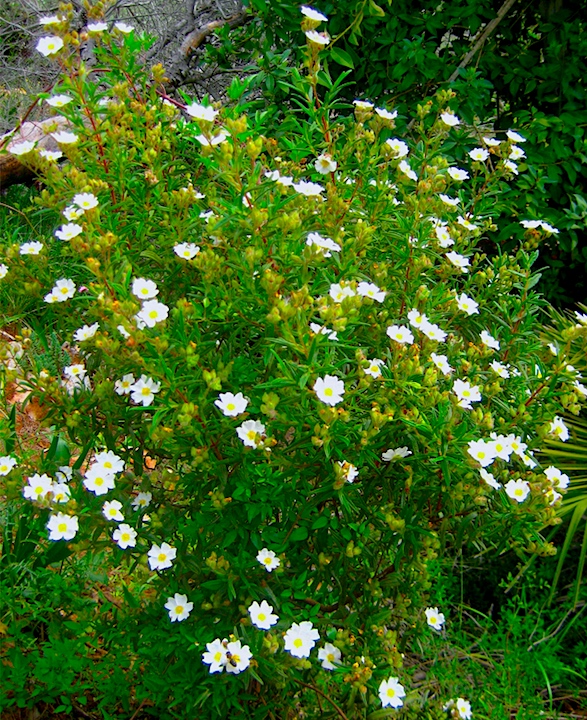
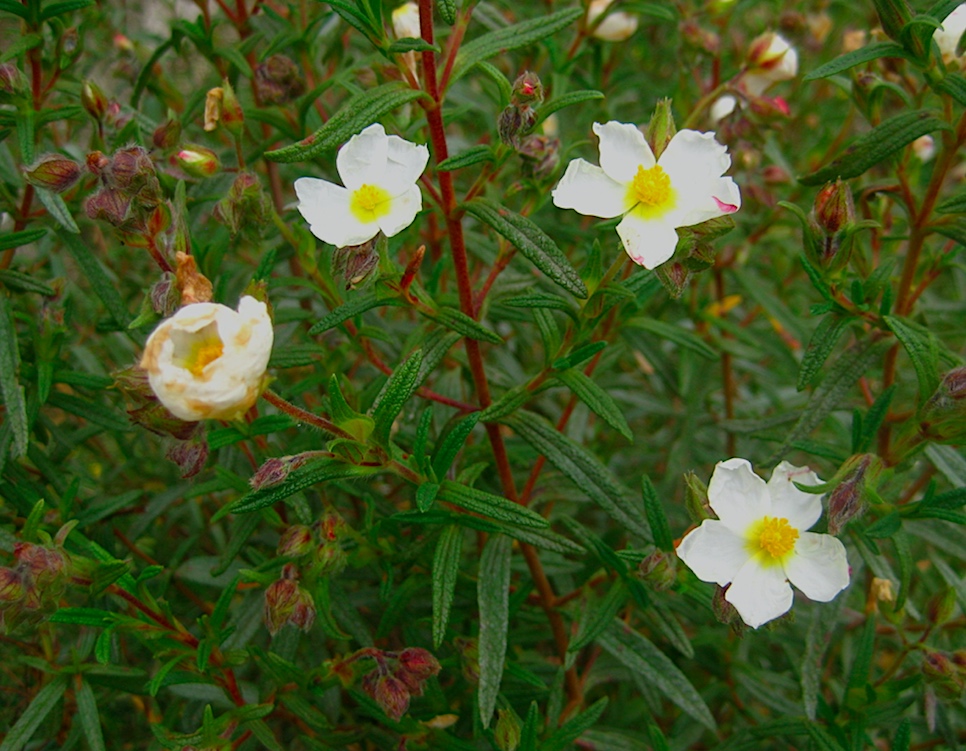
Next to appear in the garden was the grey green-leaved Cistus albidus. Albidus, meaning ‘white,’ refers not to the flowers, but the leaves that appear white from a distance due to their fuzzy coat. The flowers are pink. Called jara blanca and estepa blanca in Castellano; botja blanca in Valenciano. It is equally abundant throughout La Llacuna, and much like C. monspeliensis, found in company with gorse, wild thyme, and wild rosemary in the shrubby matorrales (maquis) near Aleppo pines, holm oaks, and wild olives.
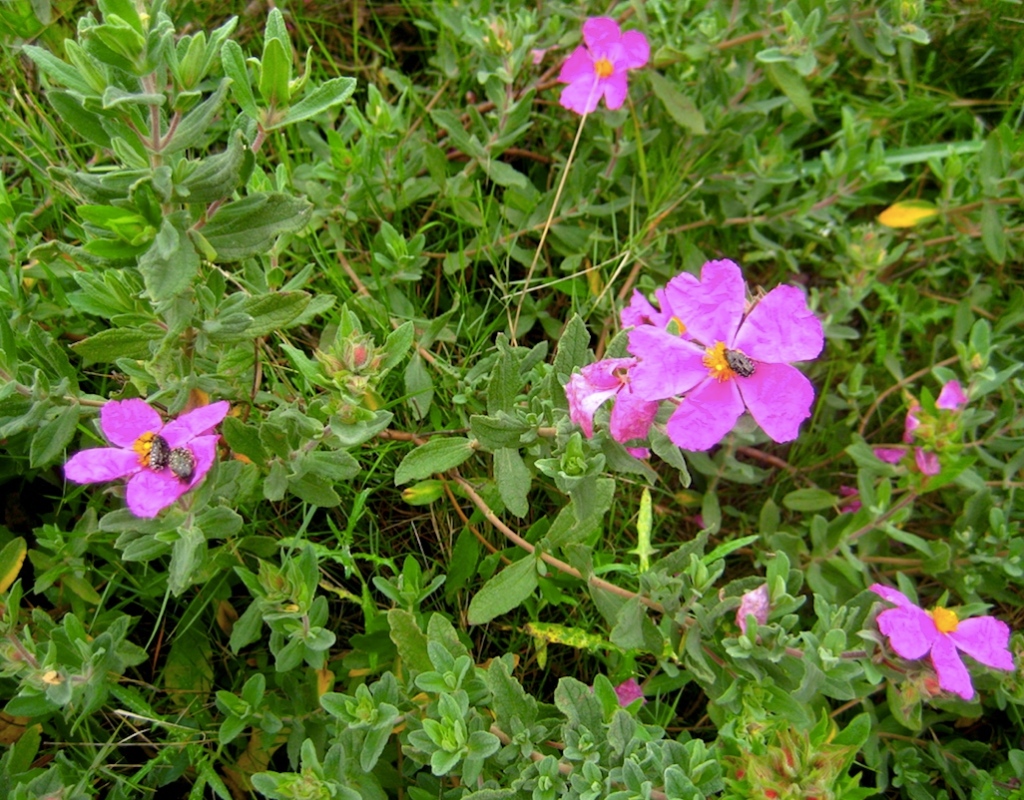
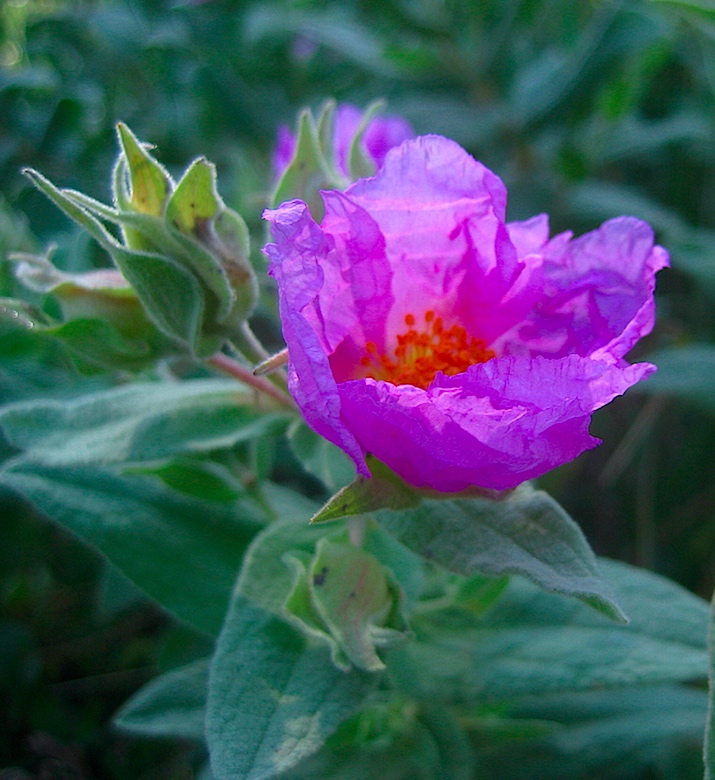
These were followed by Cistus salviifolius, whose leaves resemble those of sage, hence salvi (sage) and folius (leaf). Its flowers are white with a central ring of yellow beneath the prominent yellow stamens, much larger than the flowers of Cistus monspeliensis. This made its home among the esparto grass, ivy, and wild asparagus in the southeast corner of the garden near pines, lentisk, and olives.
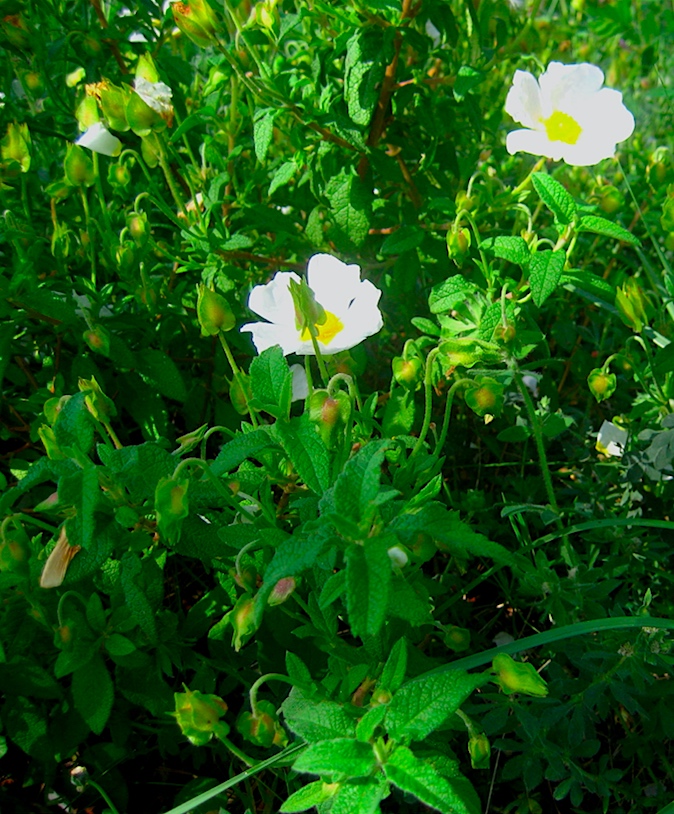
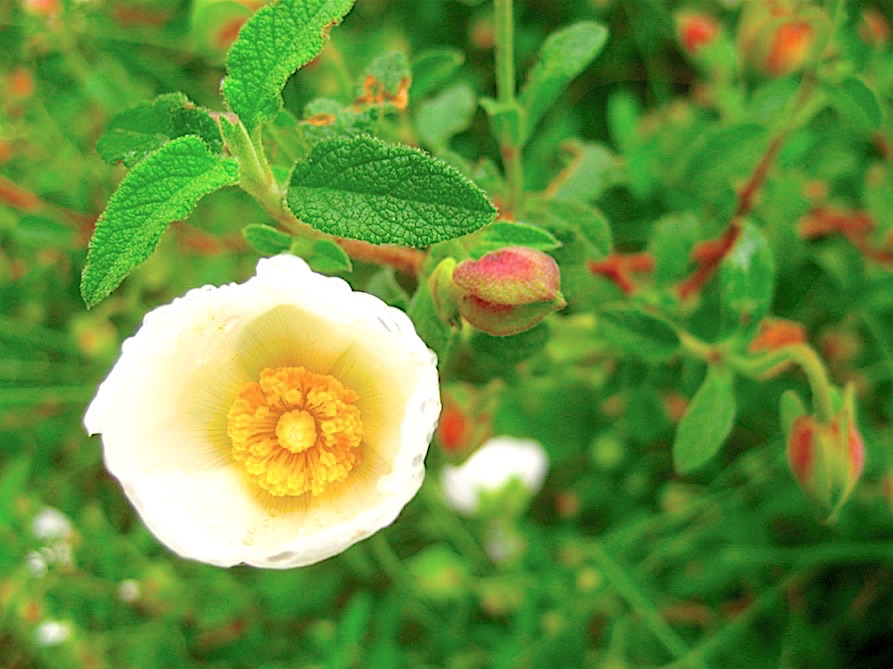
The last rockrose volunteer to arrive was Cistus crispus. It settled in the coldest, north side of the garden, just by the trunk of a tamarisk, and I mistook its shocking pink flowers to be those of C. albidus. Closer inspection revealed them to be reddish pink at the centre, fading to brilliant rose towards the edges of the petals. Their leaves resemble those of the sage-leafed rockrose, but wavy (crispus) at the edges.
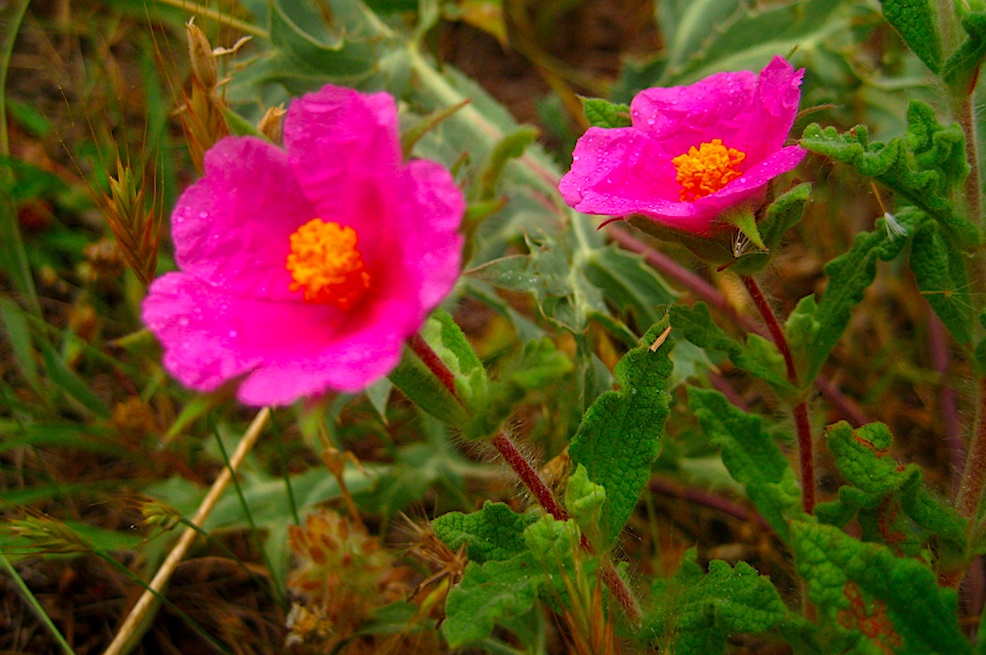
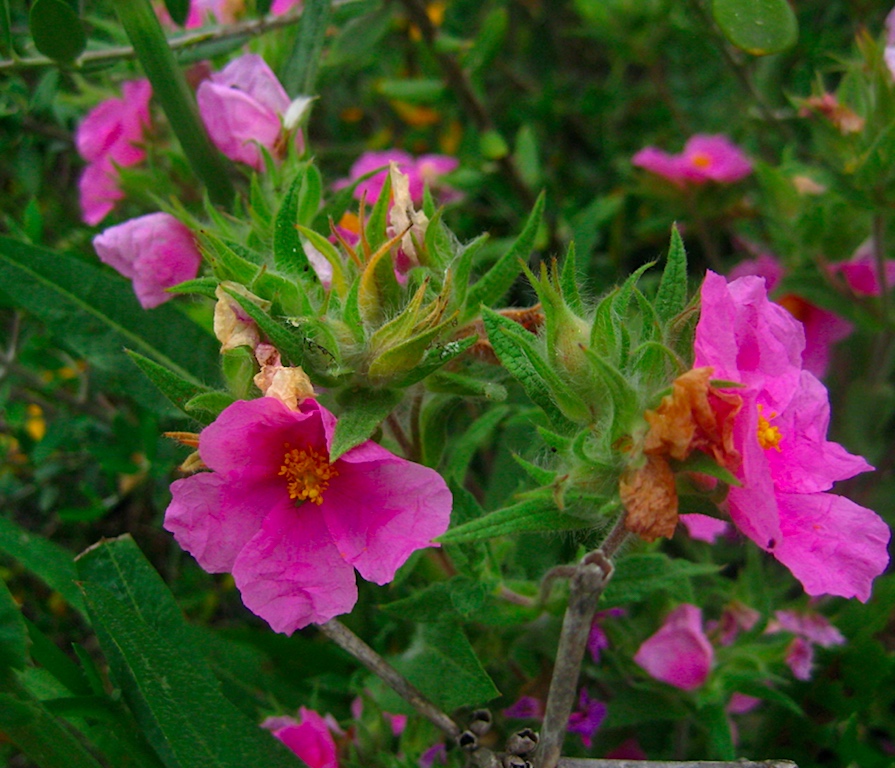
Alas that most famous of rockroses, Cistus ladanifer, hasn’t come to volunteer in my garden, though I did grow it in Warwickshire, UK. C. ladanifer is the source of the costly resin known as labdanum (different from laudanum, the 10% tincture of opium), often used in woodsy, citrusy chypre-type perfumes. Another rockrose renowned for its resin is the Cretan Cistus creticus, also traditionally drunk as tea, and is efficacious for colds and all sorts of respiratory and gastric ailments. I wondered if my volunteer rockroses had similar medicinal properties.
And indeed Cistus albidus does. It used to be taken as an infusion for gastric pain and urinary infections. North Africans use an infusion of Cistus albidus leaves as a digestive and appetite-stimulant. Further reading has turned up that Cistus albidus has anti-viral, anti-fungal, anti-bacterial, and anti-tumor properties. These multifunctional qualities made me esteem this beautiful shrub all the more, especially as it thrives without any watering or maintenance on my part.
You can imagine then how astounded I was to learn that these rockroses are known to be symbiotic with mushrooms — 16 edible types, ranging from good to excellent. Rated excellent is the níscalo, Lactarius deliciosus, aka rovellò in Valenciano. I have yet to find this fungus in my garden, although before the Cistuses made their home here, I frequently found the pale purple wood blewit, Lepista or Clitocybe nuda. This beauty is rated as good (buen comestible). It is known as pie azul (blue foot) in Castellano and peu violeta in Valenciano/Catalan.
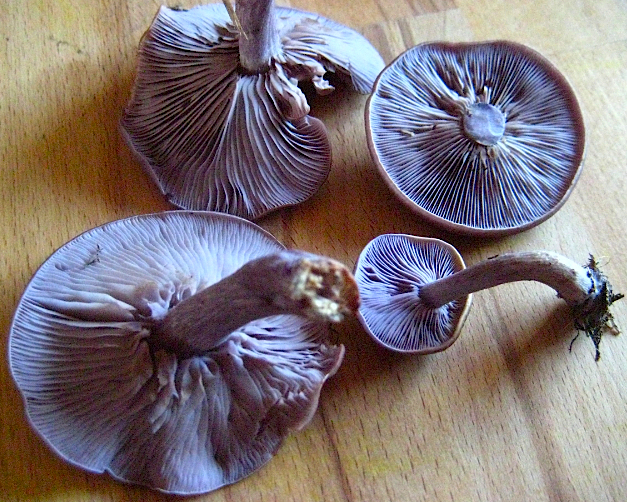

As if being symbiotic with edible fungi weren’t enough to thoroughly endear Cistus albidus to me, it now appears to host truffles. What?!? Indeed, in contrast to oak and hazel trees that produce black truffles at around 6 – 10 years of age, Cistus species, in particular C. ladanifer and C. laurifolius, and possibly C. albidus too, if inoculated with black truffle spores, start to produce them at 3 years. Truffle spores can be bought online, rather pricey at 60 Euros for 4 grams. So can edible fungi spores at 30 Euros a pop.
Somehow Spain does not immediately come to mind when one thinks of these gastronomic luxuries, France’s black Perigord truffle and Italy’s white truffle being the most mentioned. And yet, truffles are naturally found in Spain’s mountainous regions, as I gleaned from La Cocina Moderna, a cookbook published in 1857 (downloadable from Project Gutenberg). As of course the wild boars in La Llacuna know full well: the soil under the olive groves and the pine woods is constantly churned by them.
Spain is currently the world’s largest producer of cultivated black truffles: 80% of commercially sold black truffles comes from Spain, almost all exported to France. Spain’s black truffles (Tuber melanosporum) are mostly cultivated in the mountainous Aragon region, in the provinces of Teruel and Huesca to be precise. in contrast to France and Italy, dogs are trained to sniff out the Spanish truffles, 15 – 20 cm below the soil surface, and they only start to release their scent once they are ready for harvesting.
Our Valencia region does not lack for mountains with the right ecological conditions for cultivating these underground treasures. Neighbouring Castellon province has several towns that host gastronomic festivals during the black truffle season from mid-November to mid-March — Ares del Maestrat, Benassal, Catí, Culla, El Toro, and Morella. Our own province, Valencia, confusingly named similarly as the autonomous region (Comunidad Autonoma), has one town, Andilla, that produces el diamante negro, the black diamond, or el oro negro, black gold, terms locals interchangeably use for la trufa negra. Before the pandemic, one could travel along 200 km of La Ruta de Trufa Negra (the Black Truffle Route) discovering 55 towns that produce these earthly delights.
Andilla has been producing black truffles for the past 20 years, but only recently began to promote their touristic potential. Its 4th gastronomic festival (Fivatruf) with a truffle recipe competition was to take place in mid-January this year, but was called off in light of worsening cases of the pandemic. An online announcement from December last year mentioned that from mid-November to mid-March 2021 in Andilla, fresh truffles could be bought directly from producers on Saturdays from 11 am to 1 pm; and in Culla on Sundays also from 11 am to 1 pm. I’ve checked these towns’ websites to see how the stricter travel restrictions on weekends (no entry and exit from towns with populations of 50,000) affect these artisanal markets, but no updates have been posted. Not even on the Turisme (Tourism) portal of Andilla. I only hope that with ongoing vaccinations throughout the region, it may be possible to investigate these markets in late February up to mid-March, when the black truffle season ends.
As usual I have digressed. So, if I buy black truffle spores, or better still, if I collect dried wild boar poo from the churned up orchards and neighbouring woods (assuming the boars have had their fill of black truffles), and introduce them to the roots of my Cistus shrubs, will I get my own supply of diamantes or oros negros in 3 years? Hmm… an interesting (and savoury) prospect.
